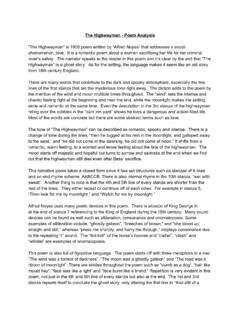Transcription of The Arabian Nights - cpb-ca-c1.wpmucdn.com
1 TheArabianNightsTRANSLATED BYHusain HaddawyBASED ON THE TEXT OF THEFOURTEENTH-CENTURY SYRIAN MANUSCRIPTEDITED BY MUHSIN MAHDID edicationFor Mike, and for Myriam,Peter, Christopher, and PageDedicationIntroductionThe World of The Arabian NightsDissemination and ManuscriptsThe Printed EditionsThe Mahdi EditionPast TranslationsThe Present TranslationThe Guiding PrinciplesThe ProseThe VerseConclusionA Note on the TransliterationMap: The World of the NightsTHE Arabian NIGHTSF orewordPrologue: The Story of King Shahrayar and Shahrazad, His Vizier s DaughterThe Tale of the Ox and the DonkeyThe Tale of the Merchant and His WifeThe Story of the Merchant and the DemonThe First Old Man s TaleThe Second Old Man s TaleThe Story of the Fisherman and the DemonThe Tale of King Yunan and the Sage DubanThe Tale of the Husband and the ParrotThe Tale of the King s Son and the She-GhoulThe Tale of the Enchanted KingThe Story of the Porter and the Three LadiesThe First Dervish s TaleThe Second Dervish s TaleThe Tale of the Envious and the EnviedThe Third Dervish s TaleThe Tale of the First Lady, the Mistress of the HouseThe Tale of the Second Lady, the Flogged OneThe Story of the Three ApplesThe Story of the Two Viziers.
2 Nur al-Din Ali al-Misri and Badr al-Din Hasan al-BasriThe Story of the HunchbackThe Christian Broker s Tale: The Young Man with the Severed Hand and the GirlThe Steward s Tale: The Young Man from Baghdad and Lady Zubaida s MaidThe Jewish Physician s Tale: The Young Man from Mosul and the Murdered GirlThe Tailor s Tale: The Lame Young Man from Baghdad and the BarberThe Barber s TaleThe Tale of the First Brother, the Hunchbacked TailorThe Tale of the Second Brother, Baqbaqa the ParaplegicThe Tale of the Third Brother, Faqfaq the BlindThe Tale of the Fourth Brother, the One-Eyed ButcherThe Tale of the Fifth Brother, the Cropped of EarsThe Tale of the Sixth Brother, the Cropped of LipsThe Story of Nur al-Din Ali ibn-Bakkar and the Slave-Girl Shams al-NaharThe Story of the Slave-Girl Anis al-Jalis and Nur al-Din Ali ibn-KhaqanThe Story of Jullanar of the SeaTranslator s PostscriptAcknowledgmentsCopyrightAlso Translated by Husain HaddawyIntroductionBless thee, Bottom!
3 Bless thee! Thou art translated. A Midsummer Night s DreamThe World of The Arabian NightsIT HAS BEEN some years now since as a little boy in Baghdad I used tolisten to tales from The Thousand and One Nights . It sometimes seems likeyesterday, sometimes like ages ago, for the Baghdad I knew then seems nowcloser to the time of the Nights than to our own times. It was on long winternights, when my grandmother was visited by one lady or another, Um Fatmaor Um Ali, always dressed in black, still mourning for a husband or a son,long lost. We would huddle around the brazier, as the embers glowed in thedim light of the oil lamp, which cast a soft shadow over her sad, wrinkledface, as if to smooth out the sorrows of the years. I waited patiently, whileshe and my grandmother exchanged news, indulged in gossip, and whisperedone or two asides.
4 Then there would be a pause, and the lady would smile atme, and I would seize the proffered opportunity and ask for a story a longstory. I used to like romances and fairy tales best, because they took me to aland of magic and because they were lady would begin the story, and I would listen, first apprehensively,knowing from experience that she would improvise, depending on how earlyor late the hour. If it was early enough, she would spin the yarn leisurely,amplifying here and interpolating there episodes I recognized from otherstories. And even though this sometimes troubled my childish notions ofhonesty and my sense of security in reliving familiar events, I never objected,because it prolonged the action and the pleasure. If the hour was late, shewould, in spite of my entreaties, tell either a brief story or one of normallength, summarizing here and omitting there.
5 If I knew the story, I wouldprotest, reminding her of what she had left out, and she, smilingly, wouldpromise to tell me the story in its entirety the next time. I would then entreather to narrate at least such and such an episode. Sometimes my grandmother,out of love for me and her own delight in the story, would add her voice tomine, and the lady, pleased to be appreciated and happy to oblige, wouldconsent to go on, narrating in a gentle, steady voice, except when sheimpersonated a man or woman in a moment of passion or a demon in a fit ofanger, at times getting up to act out the part. Her pauses were just as deliciousas her words, as we waited, anticipating a pleasure certain to come. At last,with the voice still steady but the pauses shorter and less frequent, she wouldreunite the lovers or reconcile the hero to fate, bringing the story, alas, to anend and leaving me with a feeling of nostalgia, a sense at once of fulfillmentand of loss.
6 Then I would go to sleep, still living with magic birds and withdemons who pursued innocent lovers and haunted my dreams, and oftendreaming, as I grew older, of a face in Samarkand that glowed with love andblessed my waking has the drab fabric of life been transformed into the gossamer ofromance, as these stories have been spun for centuries in family gatherings,public assemblies, and coffeehouses, in Baghdad, Damascus, or Cairo.(Indeed, on a recent trip to Marrakech, I came across storytellers in a publicsquare, mesmerizing their audiences.) Everybody has loved them, for theyenchanted the young and the old, alike, with their the Nights themselves, tales divert, cure, redeem, and save cures Shahrayar of his hatred of women, teaches him to love, andby doing so saves her own life and wins a good man; the Caliph Harun al-Rashid finds more fulfillment in satisfying his sense of wonder by listening toa story than in his sense of justice or his thirst for vengeance; and the king ofChina spares four lives when he finally hears a story that is stranger than astrange episode from his own life.
7 Even angry demons are humanized andpacified by a good story. And everyone is always ready to oblige, foreveryone has a strange story to work consists of four categories of folk tales fables, fairy tales,romances, and comic as well as historical anecdotes, the last two oftenmerging into one category. They are divided into Nights , in sections ofvarious lengths, a division that, although it follows no particular plan , servesa dual purpose: it keeps Shahrayar and us in suspense and brings the action toa more familiar level of reality. The essential quality of these tales lies intheir success in interweaving the unusual, the extraordinary, the marvelous,and the supernatural into the fabric of everyday life. Animals discourse andgive lessons in moral philosophy; normal men and women consort or strugglewith demons and, like them, change themselves or anyone else into any formthey please; and humble people lead a life full of accidents and surprises,drinking with an exhalted caliph here or sleeping with a gorgeous girl both the usual incidents and the extraordinary coincidences are nothingbut the web and weft of Divine Providence, in a world in which people oftensuffer but come out all right at the end.
8 They are enriched by the pleasure of amarvelous adventure and a sense of wonder, which makes life possible. Asfor the readers, their pleasure is vicarious and aesthetic, derived from theescape into an exotic world of wish fulfillment and from the underlying act oftransformation and the consequent pleasure, which may be best defined inFreudian terms as the sudden overcoming of an an effect, which is contingent on merging the supernatural and thenatural and securing a willing suspension of disbelief, the storyteller of theNights produces by the precise and concrete detail that he uses in a matter-of-fact way in description, narration, and conversation, bridging the gap betweenthe natural and supernatural situations. It is this quality, by the way, thatexplains the appeal of these tales to the romantic imagination.
9 For instance,the she-demon is a serpent as thick as the trunk of a palm tree, while thedemon is as thin as a spear and as long as two; the transparent curtain hidingthe gorgeous girl in the bed is red-speckled; and the seductive girl fromBaghdad buys ten pounds of mutton, while the pious gardener buys twoflagons of wine for the mysterious lovers. Thus the phantasmagoric is basedon the concrete, the supernatural grounded in the and ManuscriptsTHE STORIES OF the Nights are of various ethnic origins, Indian, Persian,and Arabic. In the process of telling and retelling, they were modified toconform to the general life and customs of the Arab society that adapted themand to the particular conditions of that society at a particular time.
10 They werealso modified, as in my own experience, to suit the role of the storyteller orthe demand of the occasion. But different as their ethnic origins may be, thesestories reveal a basic homogeneity resulting from the process ofdissemination and assimilation under Islamic hegemony, a homogeneity ordistinctive synthesis that marks the cultural and artistic history of one knows exactly when a given story originated, but it is evidentthat some stories circulated orally for centuries before they began to becollected and written down. Arab historians of the tenth century, like al-Mas udi and ibn al-Nadim speak of the existence of such collections in theirtime. One was an Arabic work called The Thousand Tales or The ThousandNights, a translation from a Persian work entitled Hazar Afsana (A thousandlegends).










